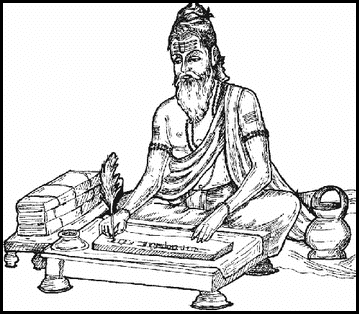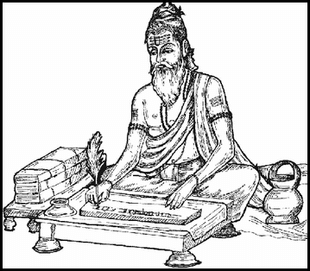Culture
A Vedic Touch To Logic In Indian Thought - Part One
Subhash Kak
Oct 09, 2016, 12:34 PM | Updated 12:33 PM IST
Save & read from anywhere!
Bookmark stories for easy access on any device or the Swarajya app.


This is the first of a two-part essay, which presents an overview of the Indian tradition of logic. The Indian tradition of logic reached its peak in the Navya Nyaya school of medieval India.
This is a general survey of the tradition of logic (anvıksikı, nyaya, or tarka in Sanskrit) in India. This tradition is very old and can be seen in its beginnings in the Rig Veda, the earliest text available from India and dated back to about 2000 BCE. The Vedic system looked at reality at two levels. At the ordinary level of apprehension it was rational and, therefore, it needed logic to describe it; but at a higher level it had a transcendental basis.
The transcendental nature was expressed in statements that were paradoxical such as the individual self was equivalent to the cosmic self (Atman equals Brahman) or fullness is present everywhere, it arises from itself, and when subtracted from itself it remains full (Isavasya Upanisad). Some have taken this latter statement to imply an intuition of the idea of infinity.
The Rig Vedic hymn 10.129, speaking of creation, mentions a time that was neither existent nor non-existent, suggesting the beginnings of representation in terms of various logical divisions that were later represented formally in Indian logic as the four circles of catuskoti: ‘A’, ‘not A’, ‘A and not A’, and ‘not A and not not A’.
Amongst the early sources of textual evidence for Indian logic are the various schools of philosophy including Nyaya and Vaisesika, dealing respectively with linguistic and physical objects. The epic Mahabharata mentions different schools of logic. The grammar of Panini (5th century BCE) uses logical categories and the rich grammatical tradition continued to influence logic and other philosophical thought. Early modern reviews of the subject are by Vidyabhusana [1],[2]; for general reviews, see the edited volumes by Potter [3],[4]; for a broad historical context, see [5],[6],[7].
The tradition of Indian logic, which developed in the background of the Vedic theory of knowledge, was divided by the historian Vidyabhusana [2] into three periods: ancient (up to 400 CE), medieval (400 CE – 1200 CE) and modern (1200 CE – 1850 CE). He saw the Nyaya Sutra of Aksapada Gautama (or Gotama) (c 550 BCE) as the foremost, if not the earliest, representative of the ancient period; Pramanasamuccaya of Dignaga as representative of the medieval period; and Tattvacintamani of Gangesa Upadhyaya as representative of the modern period. The medieval period produced many important glosses on the ancient period and much original thought. For example, Bhartrhari (5th cen- tury CE) presented a resolution to the problem of self-referral and truth (Liar’s paradox) [8]. In the modern period philosophers took up new issues such as empty terms, double negation, classification and essences.
Darsanas and the Nyaya Sutra
Logic is one of the six darsanas, which are the classical schools of Indian philosophy. These six schools are the different complementary perspectives on reality, which may be visualised as the views from the six walls of a cube within which the subject is enclosed. The base is the broad system of the tradition (Purva Mımamsa), and the ceiling represents the large questions of meaning related to the objective world and the subject (Uttara Mımamsa or Vedanta); one side is analysis of linguistic particles (Nyaya), with the opposite side being the analysis of material particles (Vaisesika); another side is enumerative categories in evolution at the cosmic and individual levels (Samkhya), with the opposite side representing the synthesis of the material and cognitive systems in the experiencing individual (yoga).
Logic is described in Kautilya’s Arthasastra (c 350 BCE) as an independent field of inquiry anvıksikı [9]. The epic Mahabharata, which is most likely prior to 500 BCE because it is not aware of Buddhism in its long descriptions of religion [10], declares (Mahabharata 12.173.45) that anvıksikı is equivalent to the discipline of tarka. Clearly, there were several equivalent terms in use in India for logic in 500 BCE.
The canonical text on the Nyaya is the Nyaya Sutra of Aksapada Gautama [11]. The most important early commentary on this text is the Nyaya Bhasya of Vatsyayana which is estimated to belong to 5th century CE. The physician Caraka, in his Samhita, speaks of the importance of the use of logic in medicine just as it was also essential to other sciences. The Nyaya Sutra speaks of three kinds of debate:
- Katha (literally, speech), where a thesis and a counter-thesis are argued by the protagonists based on evidence and argument;
- Jalpa, which may entail equivocation and false reasoning;
- Vitanda, which is characterised by the absence of a counter-thesis.
The Nyaya also calls itself pramanasastra, or the science of correct knowledge. Knowing is based on four conditions: (i) The subject or the pramatr; (ii) The object or the prameya to which the process of cognition is directed; (iii) The cognition or the pramiti; and (iv) the nature of knowledge, or the pramana.
The four pramanas through which correct knowledge is acquired are: pratyaksa or direct perception, anumana or inference, upamana or analogy, and sabda or verbal testimony.
The function of definition in the Nyaya is to state essential nature (svarupa) that distinguishes the object from others. Three fallacies of definition are described: ativyapti, or the definition being too broad as in defining a cow as a horned animal; avyapti, or too narrow; and asambhava, or impossible.
Gautama mentions that four factors are involved in direct perception: the senses (indriyas), their objects (artha), the contact of the senses and the objects (sannikarsa), and the cognition produced by this contact (jnana). The five sense organs, eye, ear, nose, tongue, and skin have the five elements light, ether, earth, water, and air as their field, with corresponding qualities of colour, sound, smell, taste and touch.
Manas or mind mediates between the self and the senses. When the manas is in contact with one sense organ, it cannot be so with another. It is therefore said to be atomic in dimension. It is due to the nature of the mind that our experiences are essentially linear, although quick succession of impressions may give the appearance of simultaneity.
Objects have qualities which do not have existence of their own. The colour and class associated with an object are secondary to the substance. According to Gautama, direct perception is inexpressible. Things are not perceived as bearing a name. The conception of an object on hearing a name is not direct perception but verbal cognition.
Not all perceptions are valid. Normal perception is subject to the existence of (i) the object of perception, (ii) the external medium such as light in the case of seeing, (iii) the sense-organ, (iv) the mind, without which the sense-organs cannot come in conjunction with their objects, and (v) the self.
If any of these should function improperly, the perception would be erroneous.
The causes of illusion may be dosa (defect in the sense-organ), samprayoga (presentation of only part of an object), or samskara (habit based on irrelevant recollection). Anumana (inference) is knowledge from the perceived about the unperceived.
The relation between the two may be of three kind: the element to be inferred may be the cause or the effect of the element perceived, or the two may be the joint effects of something else.
The Nyaya syllogism is expressed in five parts:
1. Pratijna, or the proposition: the house is on fire;
2. Hetu, or the reason: the smoke;
3. Drstanta the example: fire is accompanied by smoke, as in the kitchen;
4. Upanaya, the application: as in kitchen so for the house;
5. Nigamana, the conclusion: therefore, the house is on fire.
This may be represented symbolically as [12]:
1. A
2. Because B
3. B goes with A always; witness C
4. It is a case of B
5. Therefore, A
The Nyaya syllogism recognises that the inference derives from the knowledge of the universal relation (vyapti) and its application to the specific case (paksadharmata). There can be no inference unless there is expectation (akanksha) about the hypothesis which is expressed in terms of the proposition.
The minor premise (paksadharmata) is a consequence of perception, whereas the major premise (vyapti) results from induction. But the universal proposition cannot be arrived at by reasoning alone. Frequency of the observation increases the probability of the universal, but does not make it certain. Gangesa, a later logician, suggested that the apprehension of the universal requires alaukikapratyaksa (or non-sensory apprehension).
It was also argued that the major premise (vyapti) should be formulated negatively to ensure that the process of inference does not involve petitio principii. Let A be what has a; whatever does not differ from non-A, does not have a. The five-part syllogism would then run as:
- Not A
- Because not B
- A goes with B always; witness C
- It is not so (not a case of B)
- Therefore, it is not a case of A
The Nyaya system lays stress on antecedence in its view of causality. But both cause and effect are viewed as passing events. Cause has no meaning apart from change; when analysed, it leads to a chain that continues without end. Causality is useful within the limits of experience, but it cannot be regarded as of absolute validity. Causality is only a form of experience.
The advancement of knowledge is from upamana, or comparison, with something else already well-known. This leads us back to induction through alaukikapratyaksa as the basis of the understanding.
Sabda, or verbal testimony, is a chief source of knowledge. The meaning of words is by convention. The word might mean an individual, a form, or a type, or all three. A sentence, as a collection of words, is cognised from the trace (samskara) left at the end of the sentence. Knowledge is divided into cognitions which are not reproductions of former states of consciousness (anubhava) and those which are recollections (smrti).
The Nyaya speaks of errors and fallacies arising by interfering with the process of correct reasoning. The Nyaya attacks the Buddhist idea that no knowledge is certain by pointing out that this statement itself contradicts the claim by its certainty. Whether cognitions apply to reality must be checked by determining if they lead to successful action. Prama, or valid knowledge, leads to successful action unlike erroneous knowledge (viparyaya).
To Be Continued…
References
[1] K H Potter (ed.), Indian Metaphysics and Epistemology: The Tradition of Nyaya-Vaisesika Up to Gangesa. Delhi: Motilal Banarsidass and Princeton: Princeton University Press, 1977.
[2] K H Potter and S Bhattacharyya (eds.), Indian Philosophical Analysis: Nyaya-Vaisesika from Gangesa to Raghunatha Siromani. Delhi: Motilal Banarsidass and Princeton: Princeton University Press, 1993.
[3] S C Vidyabhusana, A History of Indian Logic. Calcutta: University of Calcutta, Calcutta, 1921.
[4] S C Vidyabhusana, History of the Medieval School of Indian Logic. Calcutta: University of Calcutta, 1909.
[5] S Kak, Aristotle and Gautama on Logic and Physics. arXiv:physics/0505172.
[6] S Kak, The Architecture of Knowledge. Delhi: CSC and Motilal Banarsidass, 2004.
[7] T McEvilley, The Shape of Ancient Thought: Comparative Studies in Greek and Indian Philosophies. New York: Allworth Press, 2002.
[8] J E M Houben, “Bhartrhari’s solution to the Liar and some other paradoxes.” Journal of Indian Philosophy 23: 381–401, 1995.
[9] R P Kangle, The Kautilıya Arthasastra. Delhi: Motilal Banarsidass, 1986.
[10] K M Ganguly, The Mahabharata. New Delhi: Munshiram Manoharlal, 1991.
[11] S C Vidyabhusana, The Nyaya Sutras of Gotama, revised and edited by Nandalal Sinha. Delhi: Motilal Banarsidass, 1990.
[12] B K Matilal, Logic, Language and Reality. Delhi: Motilal Banarsidass, 1985.
Also Read:
Subhash Kak is Regents professor of electrical and computer engineering at Oklahoma State University and a vedic scholar.





